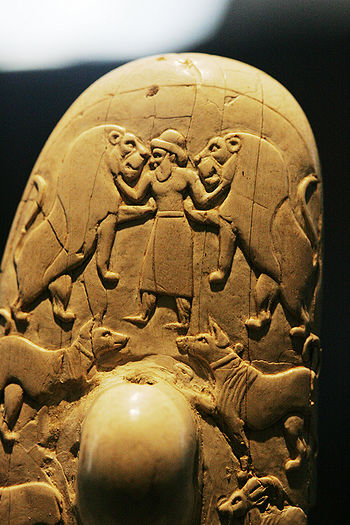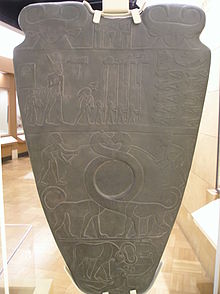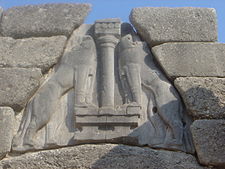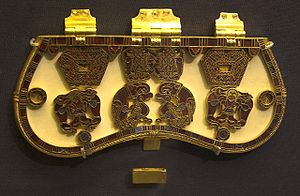- Confronted animals
-
 The Gebel el-Arak Knife, on display at the Louvre; the iconography on the reverse of the handle is two confronted lions, flanking a central figure (note confronted dogs and other animals below)
The Gebel el-Arak Knife, on display at the Louvre; the iconography on the reverse of the handle is two confronted lions, flanking a central figure (note confronted dogs and other animals below)
Confronted animals, or confronted-animal as an adjective, where two animals face each other in a symmetrical pose, is an ancient bilateral motif in art and artifacts studied in archaeology and art history. The Anti-Confronted animals is the opposing motif. Bilateral symmetry is a dominant aspect of our world and strong representation of it with matching figures often creates a balance that is appealing in artwork.
In ancient artwork, confronted-animal motifs often involve a central figure between two confronted animals, and are probably part of a unified socio-cultural motif. It is thought that the iconography sometimes has ritual and religious associations; for example, the Lion Gate of Mycenae has a column between the protective, surmounted and confronted lionesses standing with two feet on the ground and two on the same base on which the column rests. The column is thought to represent a goddess, abstracted to avoid tabooed direct representation.
Contents
Gebel el-Arak Knife
The reverse side of the Gebel el-Arak Knife handle, displayed at the top of the article, shows two powerful confronted lions, separated by a figure who is grasping them. Of note, the knob on the reverse shows the top end of the hole for a cord or rope, on the suspension lug; this knife may have been worn around the neck ceremonially.
Examples from archaeology
Cylinder seals
 Cylinder seal of Uruk displaying a confronted-lioness motif sometimes described as a "serpopard" - 3000 BC - Louvre
Cylinder seal of Uruk displaying a confronted-lioness motif sometimes described as a "serpopard" - 3000 BC - Louvre
Examples of confronted animals exist on Cylinder seals from Mesopotamia. Deities, or heroes grasping lionesses, cattle, griffins, or other imaginary creatures are sometimes found.
Many cylinder seals involving confronted goats surrounding a central Tree of life on a 'cone' or 'mountain' platform share one common theme. Others may be thought of as deities holding the animals under their control.
Because cylinder seals are numerous and also come from pre-historical periods, back to the fourth or fifth millenniums, themes are varied. Another Tree of life type of confronted animals cylinder seal has a "hero grasping water buffalo" and a "bull-man grasping lions", each between the animals; again, the central figure is the "Tree-of-Life" that often is interpreted as representing a goddess.
Confronted snakes
 Figure from Crete, holding confronted snakes, dated 1600 BC.
Figure from Crete, holding confronted snakes, dated 1600 BC.
Confronted snakes are frequent images in many cultures from ancient times to historical periods. Often associated with religious ceremonies and deities, perhaps the most familiar figure known popularly from ancient times is the deity or priestess of Crete depicted holding up two confronted snakes on either side of her.
A chlorite vessel [1] from the area of contemporary Baghdad, Iraq is displayed at this link. It depicts three pairs of confronted animals. Two confronted snakes are being held in the hands of the central figure; below the snake-pair are a pair of anti-confronted-lionesses (although they turn their heads to face each other their hind quarters are closely confronted), recumbent. The third similar pair of animals on this item are two anti-confronted bovines with a human or deity between also. Two tumbling lions and other animals are depicted to the right.
Narmer Palette
 Narmer Palette with confronted lionesses, displayed in iconographic registers - Ancient Egypt c. 3,000 BC
Narmer Palette with confronted lionesses, displayed in iconographic registers - Ancient Egypt c. 3,000 BC
The Narmer Palette, used to mix cosmetics in the receptacle on one side, has two confronted felines, sometimes called serpopards (because of their exaggerated long necks which look snakelike to some researchers) forming the receptacle. Close examination of the animals with the exaggerated, long necks supports identification as lionesses. The entire theme of the Narmer Palette, is about the pharaoh of the newly unified Ancient Egypt represented in two scenes, (palette obverse, palette reverse). On one side the pharaoh wears the crown of Upper Egypt and on the other, the pharaoh wears the crown of Lower Egypt. Thus, it is thought that the lionesses with their intertwining necks are representing two kingdoms, once separate, but now unified under one pharaoh. The lioness Bast had been the protective deity of one kingdom and the lioness Sekhmet of the other kingdom, equally important deities in each of the early Egyptian pantheons. Respectively, they were the special protectors of the pharaoh in each kingdom, who persisted as deities throughout the long history of unified Ancient Egypt. Eventually their roles diverged, however, with one becoming less of the protector and warrior deity and assigned other roles. Typically, many similar deities in the two kingdoms soon were merged, so the retention of both is thought to be the result of the long and strong tradition of each.
Examples of other confronted animals exist on many cosmetic palettes of Ancient Egypt that have been discovered. One palette has confronted-hippopotamuses; others include giraffes, geese, and other animals familiar to the Egyptians. Bilaterally depicted palm trees also are known as well on palettes.
Mycenae Lion Gate
 The Mycenae "Lion Gate" (detail) with two lionesses that flank a central column
The Mycenae "Lion Gate" (detail) with two lionesses that flank a central column
The gate to the citadel of Mycenae is shown to the right. It crowned the major entrance gateway to the ancient citadel that was the centre of the culture, Mycenaean Greece, that predated that of Greece, and is a well known example of two confronted lionesses. Debate exists in research of this image, questioning whether these are leopards or lionesses confronted with a column between them that represents the deity, but the characteristic tufts at the end of the tails confirm the species. Many images of lioness related deities are depicted with heavier manes than typical for lionesses, but that may have been the result of attempts to interpretation of the species or, unfamiliarity with the atypical dimorphic differences within this feline species.
Etruscan tomb mural
 Confronted leopards protect a banquet in the afterlife where Etruscan couples dine and are served wine from the ewers held by servers before the seating - mural in a Tomb of the Leopards burial chamber - necropolis of Tarquinia - Lazio, Italy
Confronted leopards protect a banquet in the afterlife where Etruscan couples dine and are served wine from the ewers held by servers before the seating - mural in a Tomb of the Leopards burial chamber - necropolis of Tarquinia - Lazio, Italy Main article: Tomb of the Leopards
Main article: Tomb of the LeopardsConfronted leopards appear in a tomb found in Tarchuna (Tarquinia), or Tarchna Tarchnal, the chief of the twelve cities of Etruria, a district in what is described as the Etruscan civilization that existed in Italy from 1200 BC through the 100 BC. It appears in the earliest history of Rome, which was dominated by it until early in the 330s BC. This mural features confronted leopards providing protection for a banquet in the afterlife. Frequently felines, lionesses and leopards such as these are confronted with a tree, shrub, or column between them in murals from this culture. The Etruscans are thought to have migrated from the area of Troy,[citation needed] through Greece where they absorbed many cultural elements, to Italy where they founded their culture in prehistoric times.
Asian and European art
 Purse-lid from Sutton Hoo, early seventh century AD.
Purse-lid from Sutton Hoo, early seventh century AD.
Confronted-animal motifs are found extensively in Asian art and in textiles, including rugs, across Eurasia. In Europe they are an important motif in animal style, or zoomorphic decoration, Insular art, and the Romanesque. In these contexts there may be little or nothing between the two animals, and the emphasis is on the pair themselves. Human figures are often treated in the same way, often mixed in with animals in decorative schemes - archers were especially popular in the Romanesque period.
The early Anglo-Saxon ship burial found in contemporary Great Britain at Sutton Hoo, from the seventh century AD, contains famous examples of Migration Period art.
The Sutton Hoo purse lid has three stylized confronted-animal pairs; the two side pairs, left and right, are identical, and have the animals in the person's clutched grasp. The central confronted animals are even more complex in theme.
Supporters in heraldry, not always a matched pair, continue the theme.
See also
- Book of Kells
- Tierwirbel
- Attitude (heraldry)
External links
Cylinder seal: confronted-animals
- Photo--Cylinder Seal-High Res – Two animals, each held by a deity or priest; Center Motif: Tree of life
- Photo--variation of Tree of life confronted-animals; Article – One figure is facing toward the observer.
Confronted snakes
Categories:- Iconography
- Animals in art
Wikimedia Foundation. 2010.
